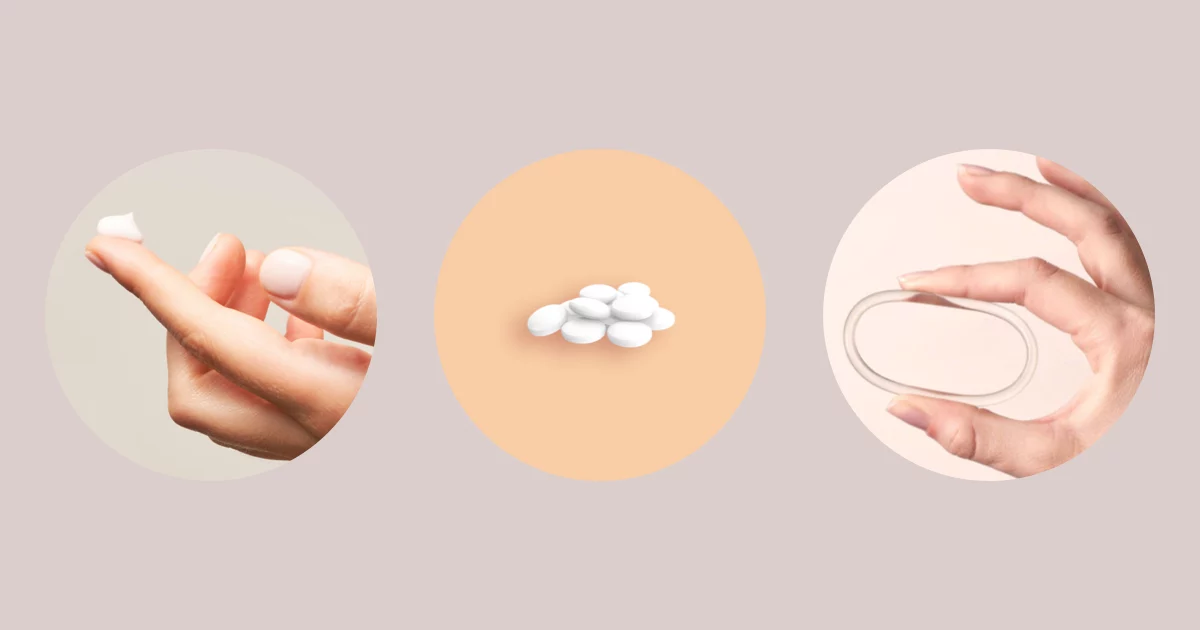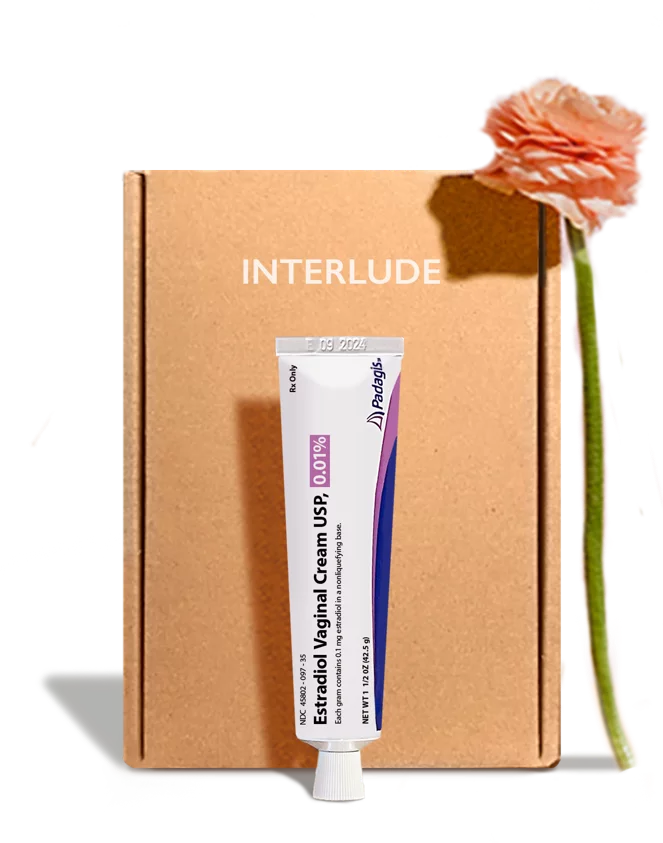Contents:
If you are a woman over 50, then you probably have had experience with vaginal dryness that caused a little discomfort.
At first, this surprising side effect of menopause may have caused pain during sex or an itchy vulva. You may have tried vaginal moisturizers or lubricants for relief.
But over time, menopause can do more than cause dryness - menopause can cause a common condition known as vaginal atrophy. Pain during sex, vaginal dryness, and frequent UTIs are classic signs of vaginal atrophy. And it can wreak havoc on your sexual wellness if left untreated.
Vaginal atrophy (also known as the genitourinary syndrome of menopause) affects up to 90% of post-menopausal women. And while it’s a perfectly natural part of aging, it doesn’t have to be your new normal.
So here’s the positive news: You can prevent and even reverse vaginal atrophy. It can be difficult, however, to sort through the various treatments available. Which ones are safe? Which ones are worth trying? We’re going to review the cause of vaginal atrophy, how to reverse it, and look at all the options for reviving dry, painful, irritated, itchy vaginal skin.
What is vaginal atrophy?
There’s a hint in the name! Vaginal atrophy is the shriveling of the skin in and around the vagina due to declining estrogen levels in menopause. The vagina and vulva have a particular shape because of estrogen. So when our bodies stop producing estrogen in menopause, the vagina and vulva lose plumpness, moisture, and form.
Vaginal atrophy symptoms include:
- Vagina feeling too tight
- Soreness during intercourse
- Reduced lubrication
- Thinning skin
- Loss of plumpness
- Loss of elasticity
Vulvar atrophy symptoms include:
- Itchy labia or clitoris
- Shrinking labia or clitoris
- Skin that looks dead or white
- Clitoral adhesion
- Frequent UTIs
- Urgency to pee
Vaginal atrophy is a chronic and progressive condition - in other words, it will not get better on its own and may get worse.
Can vaginal atrophy be reversed?
The good news is that it's possible to reverse vaginal atrophy if you address the root cause of the vaginal dryness, loss of vaginal moisture, and changes in vaginal pH.
So how can you reverse vaginal atrophy? Vaginal atrophy tends to occur when estrogen levels drop in menopause, so the most important step for reversing vaginal atrophy is determining if you are in menopause.
Menopause can begin in your 40s or 50s, but the average age is 51. There is no way to know in advance when menopause will begin, so you are post-menopause if you haven’t had a period in a year. If you have had a hysterectomy, it could be harder to tell if you are post-menopause.

Once you’ve identified that menopause is the source of your concerns, it’s time to choose a treatment to reverse vaginal atrophy - and we’ll help you with that below!
Pro tip: Ways to relieve vaginal dryness or itchiness include vaginal moisturizers and lubricants, but these treatments will not address the root cause of dryness. Antibiotics may temporarily relieve urinary infections, but will not address the root cause of changes in vaginal pH.
Vaginal atrophy treatment
Vaginal estrogen
If you’ve tried vaginal moisturizers or lubricants and your symptoms are still bothering you, it may be time to try vaginal estrogen. Vaginal estrogen is the most effective way to reverse vaginal atrophy.
Vaginal estrogen is a topical treatment that’s applied directly to the skin in or around the vagina. It works with your body by targeting the root cause of vaginal atrophy - delivering a low dose of estrogen to the estrogen receptors that are concentrated in the vaginal opening.
Restoring the health of vaginal skin with estrogen cream results in:
- Increased vaginal lubrication
- Increased vaginal elasticity
- Decreased vaginal pH
- Increased blood flow to the tissues
So, vaginal estrogen is shown to be beneficial, but how long does it take to get results? As far as vaginal moisture is concerned, you may notice increased moisture within one month of use, with full effects in 3 months. With continued use, vaginal pH rebalances, skin becomes pink, plump, and healthy, and infections become less common. Women report decreased vaginal irritation, pain, dryness, and burning. 90% of women report subjective improvement in their symptoms.
Pretty much any woman in perimenopause or menopause can use vaginal estrogen. According to a 2022 statement from the North American Menopause Society, vaginal estrogen can be taken at any age and for an extended duration. The American College of Obstetricians and Gynecologists states that women with a history of breast cancer can use vaginal estrogen with approval from an oncologist.
There are two types of vaginal estrogen medications. Estradiol, a form of estrogen that’s identical to the estrogen produced by our bodies, is available in cream, ring, and suppository forms. Premarin, an estrogen derived from the urine of pregnant horses, is available in cream form. A review of 19 clinical studies showed that all forms are similarly effective.
- Cream - Vaginal estrogen cream is usually applied to the vagina once daily for two weeks and then every 3-4 days to maintain results. The cream is applied with either an applicator or your finger tip.
- Suppository - Vaginal estrogen suppositories are usually inserted into the vagina once daily for two weeks and then every 3-4 days. Suppositories are inserted using a disposable applicator which can be uncomfortable - especially if atrophy is present.
- Ring - The vaginal estrogen ring is a plastic ring that is worn inside your vagina for three months. The ring does not need to be removed during sexual activity or bathing. Most women and their partners do not notice it at all - but the ring will sometimes fall out.

And what about the cost? While the price for brand-name vaginal estrogen has been increasing in recent years, generic estrogen vaginal cream will cost you much less.
One important note about safety. Overall, vaginal estrogen cream offers significant benefit with little risk. But it’s confusing because all prescription estrogen products carry an FDA warning that estrogens can increase the chance of developing cancer and other serious conditions. However, several women’s health experts say that vaginal estrogen is not linked to breast cancer or other serious risks and they have been lobbying the FDA to update the warning.
There are several other types of treatments available for reversing vaginal atrophy - although none so effective as vaginal estrogen. For bothersome vaginal atrophy symptoms, the North American Menopause Society and the American College of Obstetricians and Gynecologists both recommend vaginal estrogen over other options like hormone replacement therapy.
Hormone replacement therapy
Hormone replacement therapy is FDA-approved to treat menopause symptoms including hot flashes, night sweats, and vaginal atrophy. It works by replacing declining estrogen levels.
Hormone replacement therapy is prescribed as a pill, patch, or gel. It contains estrogen (and sometimes progesterone) that’s prescribed in higher doses than say, vaginal estrogen cream.
Not everyone can take hormone replacement therapy. And as with any prescription medication, you should talk with a medical provider to understand the risks and benefits. Many women are worried about hormone replacement therapy because studies show that taking oral hormones carries serious risks like clot, stroke, and cancer.
If you are concerned about the risks with hormone replacement therapy, then vaginal estrogen may be a better option for you - vaginal estradiol is not shown to significantly increase estrogen levels throughout the body and is not shown to carry significant risks.
DHEA
DHEA (also known as dehydroepiandrosterone also known as or Prasterone) is an option for women who want to reverse vaginal dryness.
DHEA is prescribed in a suppository form that is inserted into the vaginal once daily. Once the medication is in the vagina, it converts into estrogen and testosterone and has many of the same benefits as vaginal estrogen.
One downside of DHEA is that it is not as well-studied as vaginal estrogen. It also has to be applied once daily whereas vaginal estrogen is typically applied daily for about two weeks and then every 3-4 days to maintain results.
Mona Lisa treatment
The Mona Lisa treatment is a vaginal rejuvenation laser treatment that’s marketed as a way to reverse vaginal dryness. However, unlike vaginal estrogen or hormone replacement therapy, vaginal laser treatment is not FDA-approved. The safety and efficacy of this treatment is uncertain.
Frequently asked questions
-
What is vaginal atrophy?Vaginal atrophy is the shriveling of the skin in and around the vagina due to declining estrogen levels in menopause. Symptoms include vaginal dryness, pain during intercourse, frequent UTIs, and urgency to pee.
-
Can vaginal atrophy be reversed?Yes, vaginal atrophy can be reversed with vaginal estrogen cream. Vaginal estrogen cream has been shown to restore natural lubrication to the vaginal tissues. You may notice increased moisture within one month of use, with full effects in 3 months.
-
Which vaginal treatment is good for vaginal atrophy?Vaginal estrogen cream is the most effective treatment for vaginal atrophy. Vaginal estrogen cream reverses vaginal atrophy and improves vaginal health with little risk. And, unlike HRT, vaginal estrogen cream is not shown to increase risk of cancer, blood clot, or stroke.
How to get help reversing vaginal atrophy
While over-the-counter vaginal moisturizers and lubricants may be useful for women with early or mild vaginal atrophy, others may have more painful symptoms.
If symptoms are bothersome, prescription treatment may be a better option. Talk to a medical provider about your symptoms.
Without treatment, vaginal atrophy will continue to progress, so it’s better to get help sooner rather than later.




